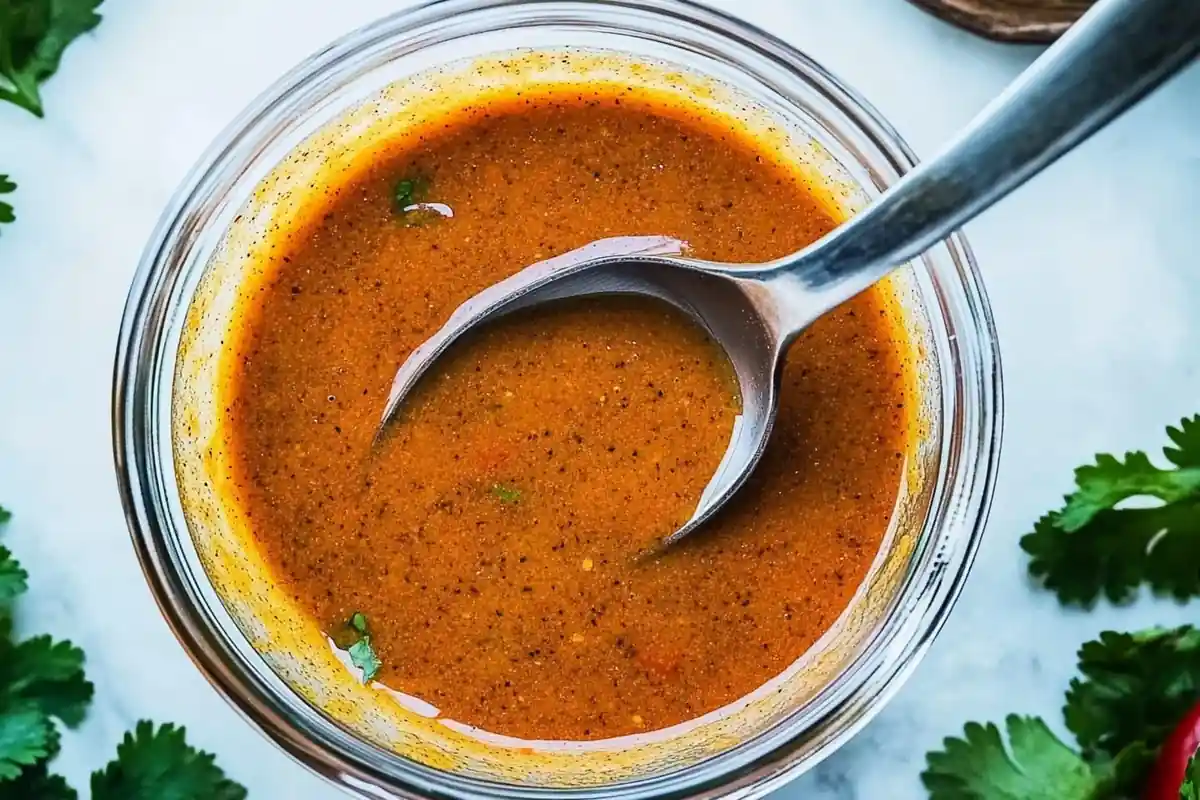An easy guide to creating the best fajita sauce recipe at home. Enhance your fajitas with this flavorful, simple, and quick sauce.
Creating amazing fajitas at home is easier than you might think, and it all begins with the perfect fajita sauce recipe. This article will guide you through creating a flavorful and versatile sauce that takes your fajitas from good to great. Moreover, we will explore everything from ingredient selection to storage solutions, ensuring you master the art of homemade fajita sauce.
What Makes a Great Fajita Sauce Recipe?
A great fajita sauce recipe hinges on balance. Furthermore, it’s about blending flavors that complement the sizzling meats and vegetables. This section explores the core components of this delicious sauce.
Core Ingredients for Your Fajita Sauce
Firstly, the base usually includes flavorful liquids. Soy sauce, lime juice, and even orange juice add both depth and brightness. Secondly, aromatics such as garlic and onions are essential. Finally, a touch of heat, like chili powder or jalapeños, elevates the overall profile.
Balancing Flavors in Your Fajita Sauce
Achieving the perfect fajita sauce requires a keen understanding of flavor balance. Sweet, sour, salty, and spicy notes must harmonize. Therefore, adjusting these elements to your preference is essential. Experiment, taste, and perfect the balance to your palate.
Step-by-Step: Creating Your Perfect Fajita Sauce Recipe
Following these steps, you can easily create a superb fajita sauce recipe at home. This section will break down the process into simple, manageable actions.
Gathering Your Ingredients
Firstly, gather all necessary ingredients. Fresh lime juice, quality soy sauce, and flavorful spices are essential. Secondly, ensure you have fresh aromatics like garlic and onion. Finally, select your preferred heat source: chili powder, fresh jalapeños, or even a dash of cayenne pepper.
The Mixing Process
After gathering your ingredients, it’s time to mix them. First, combine all the wet ingredients in a bowl. Secondly, add your chopped aromatics, spices, and any additional flavor enhancers. For example, a touch of honey can add a nice sweetness. Then, whisk everything together until thoroughly combined.
Cooking the Sauce for Enhanced Flavor
While not always required, a brief simmer on the stovetop enhances the flavors of the fajita sauce. This process allows the spices to meld together. Therefore, it creates a more robust and complex taste. Finally, simmer for about 10-15 minutes, then let it cool before using.
Variations and Customizations of Your Fajita Sauce
The beauty of a fajita sauce recipe lies in its flexibility. This section explores ways to adjust the recipe based on dietary needs and personal taste.
Spicy Fajita Sauce Options
If you love heat, several methods can enhance the spiciness. For instance, adding more chili powder or including a minced habanero will do the trick. Alternatively, consider adding a dash of hot sauce. This allows you to fine-tune the spice level to your liking.
Healthier Fajita Sauce Alternatives
For a lighter version, swap out soy sauce for a lower-sodium option. Moreover, reduce the amount of oil or use olive oil instead. Another tip is to use fresh ingredients instead of dried, which often have fewer additives.
Vegan and Vegetarian Fajita Sauce
To create a vegan fajita sauce recipe, use agave or maple syrup instead of honey. Furthermore, make sure no animal-derived ingredients are included. Moreover, it’s also a very good choice for vegetarians, making it accessible to all.
Maximizing the Flavor of Your Homemade Fajita Sauce
Achieving the maximum flavor with your fajita sauce recipe involves more than just following the instructions. This section gives helpful tips to elevate your sauce even further.
The Importance of Fresh Ingredients
Using fresh ingredients can significantly improve your fajita sauce. Freshly squeezed lime juice has a brighter flavor compared to bottled juice. Similarly, freshly minced garlic and onion deliver better aromatics.
Infusing and Marinating with Your Fajita Sauce
Allow your sauce to infuse ingredients fully. Marinate your meats and vegetables for at least 30 minutes, or ideally for a few hours. The longer the marinade, the more flavorful the result.
Tasting and Adjusting Your Fajita Sauce
Always taste your fajita sauce recipe before using it. Consequently, adjust seasonings as needed. Remember, a touch of salt, lime, or spice can make all the difference.
Using Your Fajita Sauce: Serving Suggestions and Ideas
Now that you have your fajita sauce recipe ready, what should you do with it? This section provides creative suggestions for its use.
Using Fajita Sauce as a Marinade
The primary use of fajita sauce is as a marinade. Coat your meat or veggies generously, like chicken and shrimp, then let them soak up the flavors before cooking. This step is vital to getting the most out of your sauce.
Incorporating Fajita Sauce into Recipes
Additionally, use your fajita sauce recipe to enhance other recipes. For example, stir it into rice or drizzle it over cooked fajitas for extra flavor. Its versatility ensures you can enhance various dishes.
Best Condiments and Side Dishes to Serve with Fajitas
Consider pairing your fajitas with classic Mexican side dishes. Guacamole, sour cream, and pico de gallo complement the flavors perfectly. Additionally, consider serving the fajitas with warm tortillas and a side of rice, and maybe a skinny margarita as a drink.
Storing and Preserving Your Homemade Fajita Sauce
Proper storage helps maintain the quality of your fajita sauce recipe. This section offers tips on how to store and preserve your homemade sauces.
Safe Storage Methods
Store your homemade sauce in an airtight container. It can last up to a week in the refrigerator. This method preserves the freshness of the ingredients and prevents spoilage.
Freezing Your Fajita Sauce
For longer storage, you can also freeze your fajita sauce recipe. Pour the sauce into freezer-safe bags or containers. This way, the sauce will be good for up to three months. When needed, thaw it in the refrigerator overnight.
Reheating Your Sauce
If you freeze your sauce, ensure to reheat it properly. You can reheat it in a saucepan over low heat. Alternatively, reheat it in the microwave. Make sure that it reaches an adequate temperature before using.
Common Mistakes to Avoid When Making Fajita Sauce
Even though it is simple to make, there are some mistakes to avoid with your fajita sauce recipe. This section highlights potential errors and how to prevent them.
Skimping on Quality Ingredients
Firstly, avoid skimping on the quality of your ingredients. Fresh limes and high-quality soy sauce make a huge difference. The same applies to all spices and aromatics.
Not Balancing Flavors Properly
Secondly, pay careful attention to balancing your flavors. Too much salt or spice will throw off the overall taste. Always taste and adjust accordingly.
Overcooking or Burning the Sauce
Finally, be careful when cooking the sauce. Overcooking can burn the garlic and change the taste drastically. Simmer gently and never leave it unattended.
Conclusion: Mastering Your Fajita Sauce Recipe
In conclusion, mastering a great fajita sauce recipe is within reach with a bit of care and attention. This article has covered everything from ingredient selection to storage. With practice and patience, you will create a delicious and versatile sauce that enhances every fajita night.
FAQs: All Your Fajita Sauce Questions Answered
Here are some of the most commonly asked questions about fajita sauce.
What is fajita sauce made of?
Fajita sauce typically includes a base of acidic and flavorful liquids, such as soy sauce, lime juice, and sometimes orange juice. It also contains aromatics like garlic and onions, along with spices such as chili powder and cumin. Additional elements, like honey or hot sauce, may be added for more flavor.
What is fajita marinade made of?
Fajita marinade usually comprises ingredients similar to fajita sauce, but is typically used before cooking. These often include lime juice, soy sauce, garlic, onion, and various spices. The purpose is to tenderize and flavor the meat or vegetables before grilling or cooking.
What is fajita seasoning made of?
Fajita seasoning is a dry mix. It generally contains chili powder, cumin, paprika, garlic powder, onion powder, salt, and pepper. Sometimes, it includes other spices like cayenne pepper for heat or oregano for added flavor depth.
What condiments to serve with fajitas?
Popular condiments for fajitas include sour cream, guacamole, pico de gallo, salsa, and shredded cheese. These items add a mix of creamy, fresh, and spicy components, enhancing the overall flavor of your fajitas. Moreover, consider offering lime wedges and hot sauce for extra customization.

